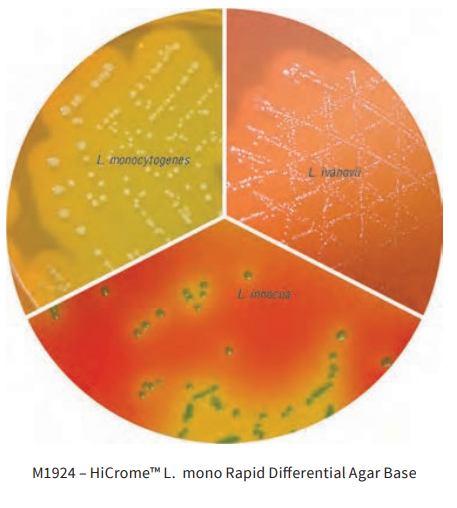HIMEDIA HiCrome 顯色培養基(/產色培養基/呈色培養基) |
顯色培養基(/產色培養基/呈色培養基)
( Chromogenic / Fluorogenic Culture Media )
顯色培養基一般是在培養基中加入檢測特定菌種的特殊性底物。
(一種或多種顯色劑(目測) 或 熒光顯色劑(紫外燈照射觀察) )
該特殊性底物 與 特定微生物自身代謝產生的酶 會產生顯色(產色)情形,
藉此直接觀察菌落顏色即可對菌種做出鑑定,
其反應的靈敏度和特異性大大優於傳統培養基。
顯色培養基通常為乾粉狀,容易儲存。
加蒸餾水溶解後,部分產品無須高壓滅菌,培養時間依具體培養基而定,
通常是18-24小時,比傳統時間顯著縮短。
HiMedia – M1924 HiCrome™ L. mono Rapid Differential Agar Base |
Recommended for the rapid identification and differentiation of Listeria monocytogenes from other Listeria species based on rhamnose fermentation and PIPLC activity.
|
Principle and Interpretation
Listeria monocytogenes is a gram-positive foodborne human pathogen responsible for serious infections in pregnant women that may ultimately result in abortion, stillbirth, birth of a child with neonatal listeriosis and meningitis or primary bacteremia in adults and juveniles. The pathogenicity of Listeria ivanovii for humans is uncertain (5). Since L. monocytogenes and L.innocua have similar biochemical properties, they cannot be differentiated on traditional media (PALCAM, Oxford). This medium is based on the specific chromogenic detection of b-glucosidase activity, rhamnose fermentation and PIPLC activity. Listeria species hydrolyse the purified chromogenic substrate in the medium giving blue coloured colonies. Since b-glucosidase activity is specific for Listeria species, other organisms cannot utilize the chromogenic substrate and therefore give white colonies. Differentiation between Listeria species is based on the property of rhamnose fermentation and PIPLC activity. The colonies of L. monocytogenes appear bluish green with a yellow halo (rhamnose positive) while the colonies of L.ivanovii appear bluish green without a yellow halo (Rhamnose negative) (1, 2). The differentiation of L.mono and L.innocua is based on PIPLC (phosphatidylinositol-specific phospholipase C) activity. Phospholipase C enzyme hydrolyses the purified substrate (FD214) added to the medium resulting in an opaque halo around Listeria monocytogenes colonies. L.ivanovii also demonstrates PIPLC activity however since it does not ferment rhamnose it can be easily distinguished from L. monocytogenes (3, 4). Peptone special, tryptone and soya peptone provide nitrogenous compounds, carbon, long chain amino acids vitamin B complex and other essential growth nutrients. Rhamnose is the fermentable carbohydrate with phenol red as an indicator. Sodium chloride maintains the osmotic equilibrium. The added lithium chloride and HiCrome™ Listeria Selective Supplement (FD181) inhibit growth of most gram- positive bacteria, gram-negative bacteria, yeasts and moulds. Phospholipase C enzyme hydrolyses the purified substrate (FD214) added to the medium resulting in an opaque halo around Listeria monocytogenes colonies demonstrating PIPLC activity.
Listeria monocytogenes is a gram-positive foodborne human pathogen responsible for serious infections in pregnant women that may ultimately result in abortion, stillbirth, birth of a child with neonatal listeriosis and meningitis or primary bacteremia in adults and juveniles. The pathogenicity of Listeria ivanovii for humans is uncertain (5). Since L. monocytogenes and L.innocua have similar biochemical properties, they cannot be differentiated on traditional media (PALCAM, Oxford). This medium is based on the specific chromogenic detection of b-glucosidase activity, rhamnose fermentation and PIPLC activity. Listeria species hydrolyse the purified chromogenic substrate in the medium giving blue coloured colonies. Since b-glucosidase activity is specific for Listeria species, other organisms cannot utilize the chromogenic substrate and therefore give white colonies. Differentiation between Listeria species is based on the property of rhamnose fermentation and PIPLC activity. The colonies of L. monocytogenes appear bluish green with a yellow halo (rhamnose positive) while the colonies of L.ivanovii appear bluish green without a yellow halo (Rhamnose negative) (1, 2). The differentiation of L.mono and L.innocua is based on PIPLC (phosphatidylinositol-specific phospholipase C) activity. Phospholipase C enzyme hydrolyses the purified substrate (FD214) added to the medium resulting in an opaque halo around Listeria monocytogenes colonies. L.ivanovii also demonstrates PIPLC activity however since it does not ferment rhamnose it can be easily distinguished from L. monocytogenes (3, 4). Peptone special, tryptone and soya peptone provide nitrogenous compounds, carbon, long chain amino acids vitamin B complex and other essential growth nutrients. Rhamnose is the fermentable carbohydrate with phenol red as an indicator. Sodium chloride maintains the osmotic equilibrium. The added lithium chloride and HiCrome™ Listeria Selective Supplement (FD181) inhibit growth of most gram- positive bacteria, gram-negative bacteria, yeasts and moulds. Phospholipase C enzyme hydrolyses the purified substrate (FD214) added to the medium resulting in an opaque halo around Listeria monocytogenes colonies demonstrating PIPLC activity.
原理與解釋
單核細胞增生李斯特菌是一種革蘭氏陽性食源性人類病原體,可導致孕婦嚴重感染,最終可能導致流產,死產,新生兒李斯特菌病和腦膜炎或成人和青少年原發性菌血症的出生。 李斯特菌對人類的致病性尚不確定(5)。由於單核細胞增生李斯特菌和L.innocua具有相似的生化特性,因此無法在傳統培養基(PALCAM,Oxford)上進行區分。該培養基基於β-葡萄糖苷酶活性,鼠李糖發酵和PIPLC活性的特異性生色檢測。李斯特菌物種水解純化的生色底物 介質給出藍色的菌落。由於β-葡糖苷酶活性對李斯特菌屬物種是特異性的,因此其他生物不能利用生色底物並因此產生白色菌落。 李斯特菌屬物種之間的分化基於鼠李糖發酵和PIPLC活性的特性。單核細胞增生李斯特菌的菌落呈藍綠色,有黃色暈(鼠李糖陽性),而L.ivanovii菌落呈藍綠色,沒有黃色暈(鼠李糖陰性)(1,2)。 L.mono和L.innocua的分化基於PIPLC(磷脂酰肌醇特異性磷脂酶C)活性。磷脂酶C酶水解添加到培養基中的純化底物(FD214),導致單核細胞增生李斯特菌菌落周圍的不透明暈圈。 L.ivanovii也表現出PIPLC活性,但由於它不發酵鼠李糖,因此可以很容易地區別於單核細胞增生李斯特菌(3,4)。 蛋白腖特殊,胰蛋白腖和大豆蛋白腖提供含氮化合物,碳,長鏈氨基酸維生素B複合物和其他必需的生長營養素。鼠李糖是可發酵的碳水化合物,以酚紅為指示劑。氯化鈉保持滲透平衡。添加的氯化鋰和HiCrome™李斯特菌選擇性補充劑(FD181)可抑制大多數革蘭氏陽性細菌,革蘭氏陰性細菌,酵母菌和黴菌的生長。 磷脂酶C酶水解添加到培養基中的純化底物(FD214),導致單核細胞增生李斯特菌菌落周圍的不透明暈,表現出PIPLC活性。
單核細胞增生李斯特菌是一種革蘭氏陽性食源性人類病原體,可導致孕婦嚴重感染,最終可能導致流產,死產,新生兒李斯特菌病和腦膜炎或成人和青少年原發性菌血症的出生。 李斯特菌對人類的致病性尚不確定(5)。由於單核細胞增生李斯特菌和L.innocua具有相似的生化特性,因此無法在傳統培養基(PALCAM,Oxford)上進行區分。該培養基基於β-葡萄糖苷酶活性,鼠李糖發酵和PIPLC活性的特異性生色檢測。李斯特菌物種水解純化的生色底物 介質給出藍色的菌落。由於β-葡糖苷酶活性對李斯特菌屬物種是特異性的,因此其他生物不能利用生色底物並因此產生白色菌落。 李斯特菌屬物種之間的分化基於鼠李糖發酵和PIPLC活性的特性。單核細胞增生李斯特菌的菌落呈藍綠色,有黃色暈(鼠李糖陽性),而L.ivanovii菌落呈藍綠色,沒有黃色暈(鼠李糖陰性)(1,2)。 L.mono和L.innocua的分化基於PIPLC(磷脂酰肌醇特異性磷脂酶C)活性。磷脂酶C酶水解添加到培養基中的純化底物(FD214),導致單核細胞增生李斯特菌菌落周圍的不透明暈圈。 L.ivanovii也表現出PIPLC活性,但由於它不發酵鼠李糖,因此可以很容易地區別於單核細胞增生李斯特菌(3,4)。 蛋白腖特殊,胰蛋白腖和大豆蛋白腖提供含氮化合物,碳,長鏈氨基酸維生素B複合物和其他必需的生長營養素。鼠李糖是可發酵的碳水化合物,以酚紅為指示劑。氯化鈉保持滲透平衡。添加的氯化鋰和HiCrome™李斯特菌選擇性補充劑(FD181)可抑制大多數革蘭氏陽性細菌,革蘭氏陰性細菌,酵母菌和黴菌的生長。 磷脂酶C酶水解添加到培養基中的純化底物(FD214),導致單核細胞增生李斯特菌菌落周圍的不透明暈,表現出PIPLC活性。
HiMedia Laboratories 的顯色培養基 產品以HiCrome為開頭命名
相較於 法國Chromagar、德國Merck、英國Oxoid、美國Remel 其他顯色培養基品牌,
HiMedia 顯色培養基產品 更多元,更豐富,品質優越。

